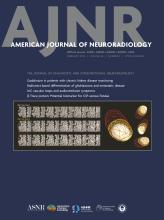This article requires a subscription to view the full text. If you have a subscription you may use the login form below to view the article. Access to this article can also be purchased.
Abstract
SUMMARY: Meningiomas, the most common primary intracranial neoplasms, account for more than one-third of primary CNS tumors. While traditionally viewed as benign, meningiomas can be associated with considerable morbidity, and specific meningioma subgroups display more aggressive behavior with higher recurrence rates. The risk stratification for recurrence has been primarily associated with the World Health Organization (WHO) histopathologic grade and extent of resection. However, a growing body of literature has highlighted the value of molecular characteristics in assessing recurrence risk. While maintaining the previous classification system, the 5th edition of the 2021 WHO Classification of Central Nervous System tumors (CNS5) book expands upon the molecular information in meningiomas to help guide management. The WHO CNS5 stratifies meningioma into 3 grades (1−3) based on histopathology criteria and molecular profile. The telomerase reverse transcriptase promoter mutations and cyclin-dependent kinase inhibitor 2A/B (CDKN2A/B) deletions now signify a grade 3 meningioma with increased recurrence risk. Tumor location also correlates with underlying mutations. Cerebral convexity and most spinal meningiomas carry a 22q deletion and/or NF2 mutations, while skull base meningiomas have AKT1, TRAF7, SMO, and/or PIK3CA mutations. MRI is the primary imaging technique for diagnosing and treatment-planning of meningiomas, while DOTATATE PET imaging offers supplementary information beyond anatomic imaging. Herein, we review the evolving molecular landscape of meningiomas, emphasizing imaging/genetic biomarkers and treatment strategies relevant to neuroradiologists.
ABBREVIATIONS:
- AKT1
- AKT serine/threonine kinase 1
- BAP1
- BRCA1-associated protein 1
- CDK4/6
- cyclin-dependent kinases 4 and 6
- CDKN2A/B
- cyclin-dependent kinase inhibitor 2A/B
- CNS5
- Classification of Central Nervous System Tumors, fifth edition
- KLF4
- Krüppel-like factor 4
- mTOR
- mammalian target of rapamycin
- NF2
- neurofibromatosis type 2
- PIK3CA
- phosphatidylinositol-4,5-Bisphosphate 3-Kinase catalytic subunit alpha
- POLR2A
- RNA polymerase II subunit A
- pTERT
- telomerase reverse transcriptase promoter
- SMARCB1
- SWItch/sucrose non-fermentable related, matrix associated, actin dependent regulator of chromatin, subfamily b, member 1
- SMO
- smoothened, frizzled class receptor
- SM
- spinal meningioma
- SUVmax
- maximum standard uptake value
- TERT
- telomerase reverse transcriptase
- TRAF7
- tumor necrosis factor receptor–associated factor 7
- WHO
- World Health Organization
- © 2025 by American Journal of Neuroradiology












